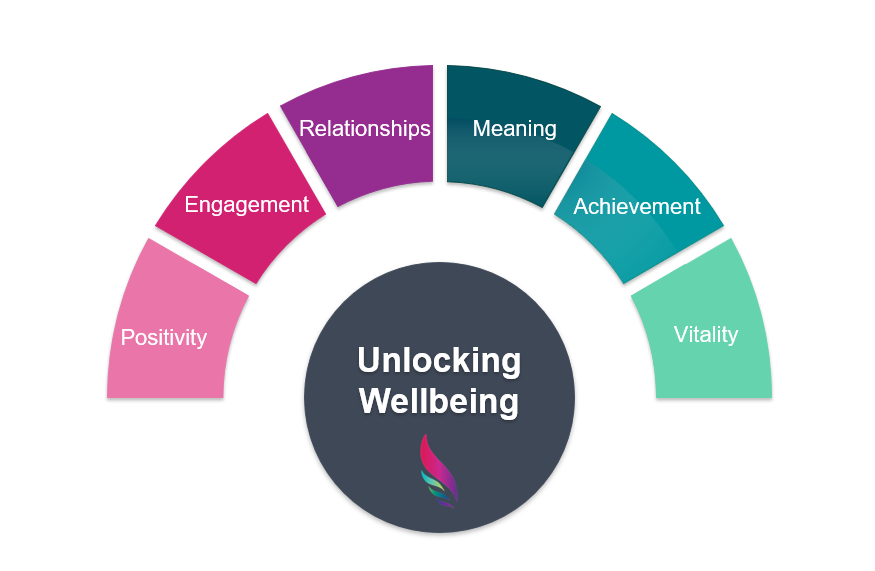
In today’s fast-paced and competitive business landscape, organizations are increasingly recognizing the significance of employee wellbeing as a catalyst for enhanced retention rates and sustained employee engagement. As the old adage goes, “Happy employees are productive employees.” However, this isn’t just a sentiment; it’s grounded in the scientific principles of positive psychology (the science of wellbeing), particularly the PERMA-V model. By leveraging this framework to implement wellbeing initiatives, organizations can not only boost employee satisfaction but also fortify their workforce, leading to improved retention rates and a flourishing organizational culture.
The PERMA-V model, a cornerstone of positive psychology developed by Martin Seligman, encapsulates five essential elements that contribute to a person’s overall wellbeing: Positive Emotions, Engagement, Relationships, Meaning, Achievement, and a sixth element, Vitality, later introduced by Emiliya Zhivotovskaya. When transposed to the workplace, this model serves as a blueprint for fostering an environment that not only supports employee wellbeing but also generates a profound impact on retention and other aspects around human resourcefulness.
Positive Emotions: Infusing Joy into the Workplace
Introducing positive emotions into the work environment can have a profound influence on employee morale and retention. Small gestures like recognizing accomplishments, celebrating milestones, and fostering a culture of appreciation create a positive atmosphere that encourages employees to invest their energy and loyalty into the organization. Incorporating resilience skill building programs, mindfulness sessions, and other engaging activities can further nurture these positive emotions, leading to a more satisfying work experience and heightened commitment to the organization’s mission.
Engagement: The Art of Immersive Work
Engagement, the second pillar of the PERMA-V model, revolves around engrossing employees in their tasks and roles. Organizations can harness this concept by aligning employees’ strengths with their responsibilities and providing opportunities for skill development. When individuals feel their talents are recognized and honed, their sense of purpose and commitment deepens, resulting in increased job satisfaction and a desire to stay and contribute.
Relationships: Cultivating Meaningful Connections
Building strong interpersonal relationships within the workplace can significantly impact employee wellbeing and retention. Encouraging teamwork, collaboration, and open communication fosters a sense of belonging, which in turn boosts job satisfaction and the willingness to stay with the organization. Implementing mentorship programs, team-building activities, and cross-functional projects can facilitate the creation of these meaningful connections, solidifying employees’ commitment to the organization.
Meaning and Accomplishment: Fueling Intrinsic Motivation
When employees find meaning in their work and experience a sense of accomplishment, they are more likely to remain engaged and loyal. Organizations can create a sense of purpose by aligning employees’ tasks with the organization’s values and overarching mission. Regular feedback and recognition for achievements further fuel intrinsic motivation, empowering employees to take pride in their contributions and view their work as a vital piece of the larger puzzle.
Vitality: Nurturing Physical and Mental Wellbeing
The final pillar of the PERMA-V model, vitality, emphasizes the importance of physical and mental health. Encouraging a healthy work-life balance, providing access to resources, and promoting mental health awareness initiatives can significantly impact employee wellbeing and retention. Organizations that prioritize the holistic health of their employees signal that their workforce is valued beyond their professional roles, leading to a higher level of satisfaction and commitment.
Does Investing in Wellbeing Impact Retention?
Implementing workplace strategies rooted in the PERMA-V model directly translates into enhanced employee engagement, satisfaction, and ultimately, retention. By fostering an environment that addresses employees’ emotional, intellectual, and physical needs, organizations create a virtuous cycle wherein employees are more likely to stay, invest their efforts, and contribute to the organization’s success.
In a world where the competition for top talent is fierce, investing in employee wellbeing is no longer a luxury—it’s a strategic imperative. Organizations that embrace the PERMA-V model and integrate its principles into their workplace strategies not only create a nurturing and supportive environment but also position themselves as employers of choice. As word spreads about an organization’s commitment to its employees’ overall wellbeing, it becomes a beacon that attracts and retains the best talent.
In conclusion, employee wellbeing is not merely a feel-good concept; it’s a proven driver of retention and engagement. The PERMA-V model offers a comprehensive framework for cultivating a work environment that nurtures positive emotions, engagement, relationships, meaning, accomplishment, and vitality. By embracing this model and implementing strategies that prioritize employee wellbeing, organizations can foster a culture of thriving individuals, leading to heightened job satisfaction, increased retention rates, and a brighter future for both employees and the organization.
Presented by

Archives
Categories
- Attraction and Recruitment
- Benefits
- Celebrating Success and Recognition
- Change Management
- Coaching and Conflict Resolution
- Culture
- Diversity, Equity and Inclusion
- Emotional Intelligence
- Employee Engagement
- Employee Performance
- Labour Disruption
- Mentoring
- OMHRA activities
- OMHRA Events
- Psychological health and safety of the HR professional
- Recruitment
- Recruitment and Retention
- Retention
- Uncategorized
- Unique ideas for recruiting in a tight job market
- Wellness
Recent Posts
- How Leadership Development Coaching Provides Better Outcomes
- Better Leadership: Focus on a Coach Approach
- Creating a Psychologically Safe Workplace
- Group Health Insurance – The Impact of Preferred Pharmacy Networks on Employees’ Mental Health
- Provide Real Support For Your Mid-Career Team’s Psychological Resilience
